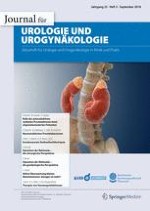05.09.2018 | Originalien
Extrakorporale Stoßwellenlithotripsie
Erschienen in: Journal für Urologie und Urogynäkologie/Österreich | Ausgabe 3/2018
Einloggen, um Zugang zu erhaltenZusammenfassung
Die interventionelle Steintherapie beinhaltet im Wesentlichen 3 Therapiemodalitäten. Hierbei stellt die extrakorporale Stoßwellenlithotripsie (ESWL) neben der Ureterorenoskopie (URS) und der perkutanen Nephrolitholapaxie (PCNL) einen wesentlichen Behandlungspfeiler sowie die einzige nichtinvasive Behandlungsoption von Steinen im Harntrakt dar. Nach einer langen Phase der hohen Akzeptanz der ESWL sank in den letzten Jahren die Anzahl an ESWL-Interventionen zugunsten der beiden anderen Therapiemodalitäten (URS und PCNL). In diesem Artikel werden die Indikationen, die Operationstechnik und die Komplikationen sowie das Komplikationsmanagement des Eingriffs beschrieben.
Anzeige
